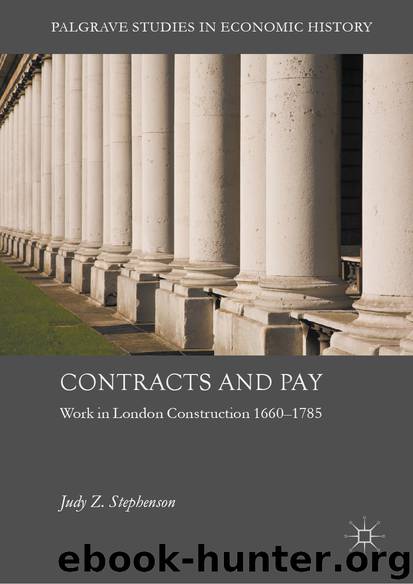Contracts and Pay by Judy Z. Stephenson

Author:Judy Z. Stephenson
Language: eng
Format: epub
ISBN: 9783319575087
Publisher: Springer International Publishing
Carriage
Carriage costs would have been considered and accounted for as part of materials costs, not labour bills, and obviously they would not have been part of ‘by the day’ labour rates. Since many bills charged for the final product by the piece, which involved a combination of materials, carriage, and labour the uncertainties and quantity of them is relevant to discussion of operating margin.
For contractors who were providing materials or final products on contracts by the great or measurement, there were substantial costs of carriage to take into account. Peter Guillery’s recent case study of construction at Cavendish Square in the 1750s and 1770s highlighted that as much as half the cost of stone used on such projects was the cost of carriage to site in London.60
Given this, the amounts that institutions accounted for carriage are surprisingly small. At Westminster Abbey 1713–1720 outwards carriage for the Abbey ranged from £37 to £48 per annum, on an approximate annual expenditure of £3000. Of the total works bill for that seven-year period of £15,789, £290 was billed by the carter, Richard Adams, at a rate of 1s. per load. At Westminster Abbey, Elizabeth Gregory provided two large mast trees in August 1714 at a total of £10 7s. 8d. and was allowed cash for the purchase. There is no mention of carriage for this in the accounts. There are no purveyor’s bills at Westminster Abbey, and no separate bills for stone during the period 1712–1719. This firmly implies Gregory and Tufnell were providing materials and providing and paying for inwards carriage for it. At Westminster Bridge “contracts entered into by the board” do not include carriage.61 The cost of carriage inwards would have been borne by the contractors’ supplying materials. Carriage was required for all goods inward: stone; mortar; timber and scaffolding; tools; ironmongery; lifting equipment and other items.62
The business of carriage was subject to significant risk for contractors due to weather and other problems. Thomas Gilbert and Thomas Wise’s contract to supply Portland to St Paul’s Cathedral discussed above, specifically stated including delivery to a London Wharf.63 When they attempted to charge cost for cranes and rope to assist the transport, the Cathedral would not allow the bills.64 At St Paul’s some carriage in was recorded, costing between 2s. and 2s. 6d. “per tun”. Whilst the cost of carriage was undoubtedly built into materials bills, the unpredictability of it necessitated management and a margin for error in financing works.
Download
This site does not store any files on its server. We only index and link to content provided by other sites. Please contact the content providers to delete copyright contents if any and email us, we'll remove relevant links or contents immediately.
Kathy Andrews Collection by Kathy Andrews(11325)
The remains of the day by Kazuo Ishiguro(8395)
Paper Towns by Green John(4800)
Spare by Prince Harry The Duke of Sussex(4788)
Industrial Automation from Scratch: A hands-on guide to using sensors, actuators, PLCs, HMIs, and SCADA to automate industrial processes by Olushola Akande(4604)
The Body: A Guide for Occupants by Bill Bryson(4584)
Be in a Treehouse by Pete Nelson(3648)
Machine Learning at Scale with H2O by Gregory Keys | David Whiting(3627)
Harry Potter and the Goblet Of Fire by J.K. Rowling(3609)
Never by Ken Follett(3528)
Goodbye Paradise(3446)
The Remains of the Day by Kazuo Ishiguro(3139)
Into Thin Air by Jon Krakauer(3131)
The Cellar by Natasha Preston(3077)
The Genius of Japanese Carpentry by Azby Brown(3039)
Fairy Tale by Stephen King(2949)
120 Days of Sodom by Marquis de Sade(2941)
Drawing Shortcuts: Developing Quick Drawing Skills Using Today's Technology by Leggitt Jim(2940)
The Man Who Died Twice by Richard Osman(2808)
